Equipment
ZS6DX/ZS2M
POTA South Africa
Equipment
ZS6DX/ZS2M
![]()
Some information on the equipment
I use for POTA activations as well as SOTA, Field day and just general hiking.
This includes current equipment (at the top of the page) as well as historic
equipment (at the bottom of the page).
As I change and upgrade
equipment often this page is always "Work in Progress"
Current equipment - 2024
At the moment I have a few radios I use for POTA/SOTA and hiking. The
radio I select depends on how far I am planning on hiking, how important light
weight is and if there is a requirement for more than 5 to 10W.
Most of
the time I only run 5W but I have found that with the limited number of local
CW operators and only a few more SSB operators, it is often difficult to get a
full activation (10 contacts) when only running 5W especially on SSB.
It is also unfair to local hunters when you run such low power and the cannot
hear you. So my current active collection of radios allow me to run from 5W
(or less) up to 100W. For the 3 low power radios (Yaesu FT-817, R928+ and
Xiegu X6100) I have the option to add the fantastic little Micro PA50
amplifier. This is a RF sensing, auto band changing amplifier that will give
you a clean 55W output with a 2-4W drive depending on band. See the photo
below.
Yaesu FT-891
This is now my primary
radio when I am not too worried about weight, it replaced the FT-897D in my
line-up. It is a stunning radio, it is compact and very well built. The
receiver sounds fantastic and the 3KHz roofing filter that comes standard is
great. The IF based DSP driven variable band width control is also great.
The radio has CW as well as SSB memories so you can record standard things
like CQ calls, this helps a lot after few hours during a contest or
activation, it really saves your arm/hand (CW) or your voice (SSB)
The
radio has a current draw of around 650ma on receive, this is far better than
other 100W radios, a big plus when you are running from batteries you had to
carry.

Yaesu
FT-891, I love it!
The FT-891 is now my preferred radio unless minimum weight is a must.
Xiegu X6100
This is a great portable SDR radio. It is
compact, light, has an internal battery that will last 2 to 3 hours, enough
for a POTA activation and it has a great receiver. The radio runs Linux so you
can actually log into the radio on operating system level and make
changes or load new software.
The radio also has a great screen visible
in daylight, unlike some of the other SDR radios on the market today.
The internal tuner works well and it really convenient, will tune all the
antennas I have tried on it so far.
The radio will run 5W on the
internal battery or 10W on an external 12V supply. When I need more than that
I use the Micro PA50 amplifier.
The radio has an internal sound card
and USB port so CAT control and interfacing a computer to run Winlink does not
require an additional interface, just a USB cable.

Xiegu
X6100
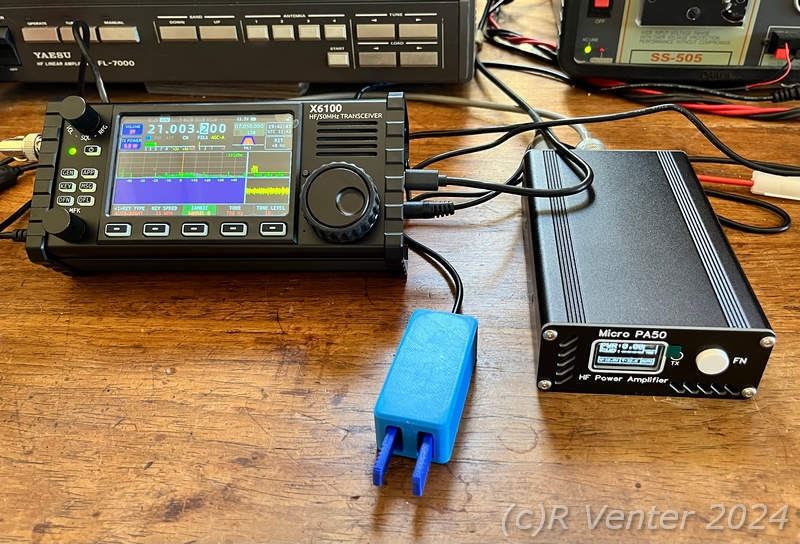
X6100 with 3D printed paddle and Micro PA50 amplifier.

Micro
PA50 amplifier, also shows you power output, SWR, voltage, band and
temperature of final transistors.

X6100 in the
field
The X6100 does have
few issues. It can run quite hot so on a hot summers day you really need to
supply additional cooling. I have also had a few lock-ups when transmitting
CW, the radio would simply stay in transmit and you have to force a switch-off
by holding the on/off button down for about 30 seconds. This has only happened
a few times and not recently. I did do a firmware upgrade and since then it
seems fine I hope it stays like that!
You can key (for CW) the radio
using RTS via the USB cable, this is useful when you are running contest
logging software like N1MM+, unfortunately this is not implemented well as it
will truncate elements while sending quite often, and not just at the start of
the transmission. This makes this great feature useless, maybe a future
firmware update will solve this.
Keying via the CW key/paddle port is
fine.
The standard microphone cable that comes with the radio is not
shielded so, especially if you use an amplifier, you will get RF feedback into
the audio circuit. This has been reported by many users. Until I can find a
shielded microphone cable this makes the use of more than 10W not feasible on
the X6100 on SSB, exactly the time you need it. At the moment I will only use
the FT-891 when I need more than 10W on SSB. On CW higher power is fine.
I do like the X6100 a lot but as it is now it does have limitations so it
is used less than it could be if everything worked the way it should.
R928+
This is a nice, cost effective little SDR radio
from China.
It will run up to 8-11W, depending on the band. It has an
internal battery but it is quite small, on 5W I seldom get more than 1 hour
out of it. It does not have an internal tuner like the X6100 so if the antenna
you are using has a SWR that is higher than it should be you need an external
tuner.
I have used a few external tuners with this radio and the FT-817
in the past. The LDG tuner works great but it is quite large. Recently I
started using the tiny ATU 100 tuner and it is fantastic! I also use it when
the Micro PA50 amplifier is in use.
Initially I had some issues with
the R928+. The audio on SSB was terrible! I managed to solve this by re-doing
the complete setup and re-calibration of the system. You need to start with
setting the bias on the finals and then all the settings per band. It is quite
a proses but yielded a radio that works well.
Just as I was happy with
the radio and wanted to take it out for a QRP portable contest it suddenly
developed a boot problem, it would get stuck in self diagnostics. It gave up
on it for almost a year before I had a look at it again. It turned out to be a
tiny, almost microscopic, piece of loose solder that caused a short circuit on
2 of the pins on a processor. Once that was cleared it worked well again, for
a while.
Next it suddenly stopped outputting any power in TX, again it
went into a drawer, I though the finals were blown. After a few months I took
it out again and opened it up, planning to remove the finals to check them. I
discovered a few bad (dry) solder joints on the finals. Once I re-flowed those
the radio was fine again, and still is.
The problem is I don't really
trust it and I won't take it out of a hike or activation as the only radio.
Maybe this will change if it behaves but for now it remains a "second" radio
on an activation.

R928+, a
great radio when it is working!
Paddles
For POTA CW activations I have 2 paddles I use at
the moment. The little 3D
printed one with a magnetic "spring" and a very nice stainless steel paddle
that I imported from China. They both work well, the 3D printed version is
lighter but the stainless steel version is more sturdy and has a better
"feel".
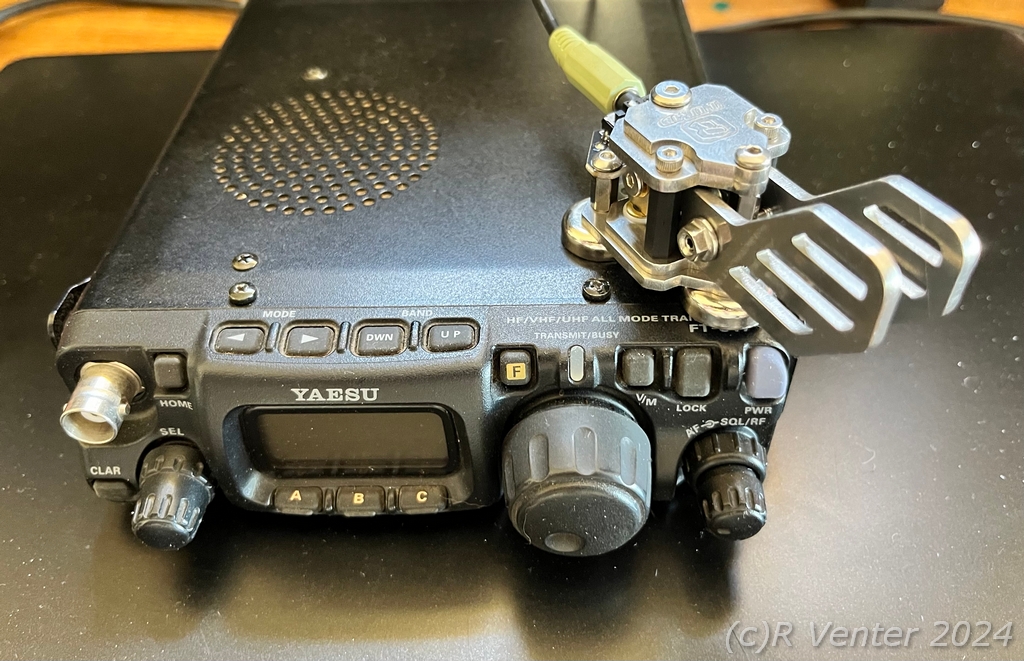
Stainless
steel paddle attached to FT-817 with it's magnets.

The little
blue 3D printed paddle can be seen above.
Tuners.
Here are the two tuners I use in the field,
both work well but the ATU-100 is so small and compact plus it works so well
that I now use it most of the time.
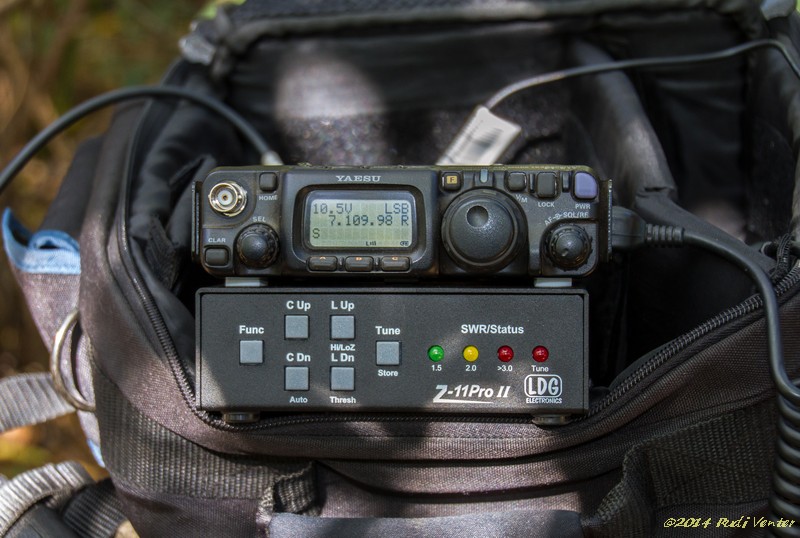
The LDG
Z-11Pro II tuner beneath the FT-817.

The
ATU-100 tuner, it show you power out, SR and what matching was needed to get a
low SWR.
Antennas.
For years I used either dipole antennas (single band) or fan-dipole
antennas (multi band) when out in the field. They worked well but the fan
dipoles were a pain to put up and you were always a bit limited as far as
useable bands were concerned.

2 band
fan-dipole in the bush.
Recently I
decided to try an EFHW (End Fed Halve Wave) antenna with a 49:1 transformer.
When cut to the correct length, easy with my nanoVNA, this antenna will
resonate on 40, 20, 15 and 10m, no tuner needed, and with the addition of a
loading coil/trap you can add 80m. It only needs a single support an one
point, can be at ground level, to tie the end to.
It works really well
and has now become my standard "away from home" antenna.
Antenna mast.
I have been using a Comet 8m aluminum mast for
quite a while now. It works great and it is sturdy. My only complaint is
weight and bulk, it is not fun to carry over any longer distance! With this in
mind I have just ordered a Spiderbeams 12m fiber glass mast. Not only is it
more compact when collapsed, it is longer when extended and lighter. Once I
have used it I will report back on it.
Batteries.
I bought 2 new "22Ah" Lithium batteries
specifically for POTA and SOTA. Once I received them I was really surprised at
how light they were, but I smelled a "rat", I have been using Lithium
batteries for a very long time and I have a pretty good idea of the
weight/capacity ratio.
So I
decided to run a full charge - discharge - charge cycle on the "22Ah" Lithium
battery I bought for POTA. Well, to my not so big surprise my suspicion was
confirmed, the "22Ah" battery is actually a 12Ah battery! Seems like you
cannot trust the specifications of stuff that is manufactured in China! Shame
on you!
I opened up one of the two packs a have only to find a battery,
shrink rapped, in the case that does not even fill half the case.
But
all is not lost, I operated for more than 2 hours (Activating ZA-0078) at
mostly high power and used 5.2Ah so the pack would still be good for at least
4-5 hours of high power use and more than double that for low power use.
Perfect for POTA and SOTA use. That combined with the light weight, and maybe
smaller size as I am considering removing the "real" battery from the pack to
save space, still makes this a great POTA/SOTA battery, just a shame about the
lies from the manufacturer (Ingle)!

The "22Ah"
battery that is actually 12Ah.
Historic equipment - Pre 2024
Yaesu FT-890/850
This was one of my first HF
radios, I first used it while on a DX pedition with two other hams in
Swaziland. After that I used it for a long time during field days and
while camping. I also used it for 2 years on a sailing yacht. This was before
POTA or SOTA, from around 1998 to 2001.
The radio worked well (I still
have it in my collection). By today's standards it is large and heavy and I
would never consider taking it on a hike but back then it was perfect for the
job.
Over the years I had two issues with it, first the VFO tuning knob
seized, it took a lot of work to get it free again but 24 years later it is
still fine. I think the original issue was no lubrication in the brass bearing
from the factory.
The second issue was a sudden jump in frequency after
heating up that it developed after a few years. It turned out to be a
faulty/aging variable capacitor in the reference oscillator. Once I tracked
down the problem and replaced the component it was fine again.
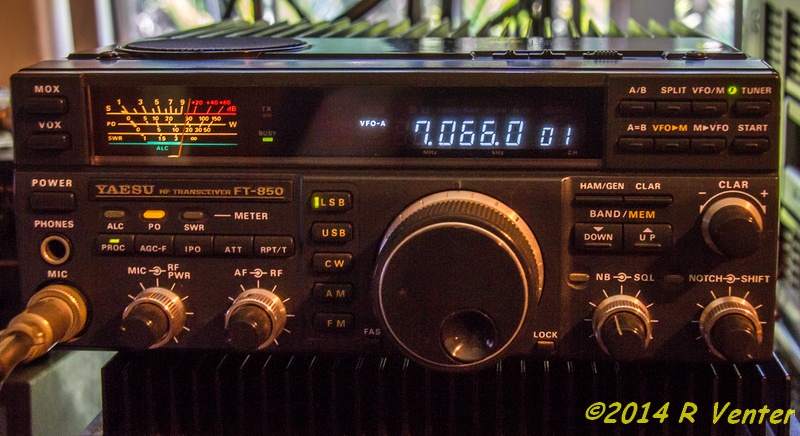
Yaesu
FT890/850
The FT-890 was replaced
by the Icom IC-706 mk2
ICOM IC-706 mk 2
Around
1999 I acquired this radio specifically to use mobile and for SOTA that was
just starting up. It was also the radio that I used for my first SOTA
activation,
Magaliesberg ZS/GP-008, This was also the very first
SOTA activation in South Africa. I was part of the team that originally mapped
peaks in South Africa.

Icom IC-706
mk 2 complete with external AT-180 tuner.
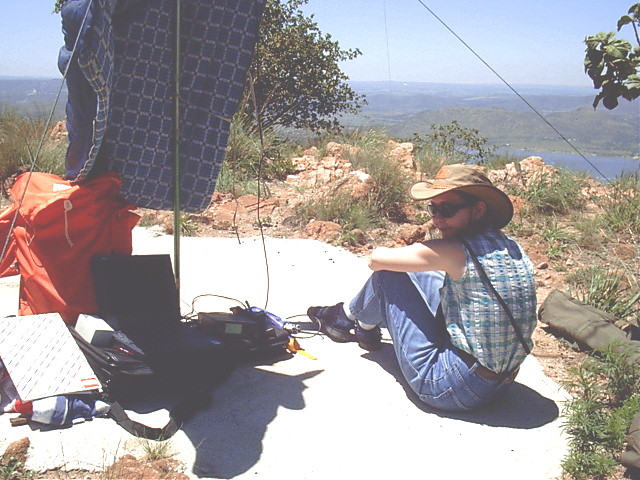
IC-706, in the
shade, on ZS/GP-008. 1 January 2003
I used the IC-706 for a while but I must admit I never liked the very harsh
audio and the high levels of "white noise" on the air.
Yaesu
FT-897D and FT-857D
I eventually sold it and replaced it with
a larger, but far better radio the Yaesu FT-897D. At the same time I also
bought a Yaesu FT-857 but I never really used to in the field. The audio was
very similar to the IC-706 so in total I spent less than 1 hour on the air
with it before I sold it again. It was also terrible on CW!

Yaesu
FT-857D, nice and compact but I did not like the sound.
The Yaesu FT-897D was a far better radio as far as I am concerned. It had a far quieter receiver and it worked well on CW. For the next 20 years it was my main SOTA/Field day radio. I still have the radio today (with the matching tuner) and as recently as a few months ago, before I acquired the FT-891, I still used it in the field.

Yaesu
FT-897D with tuner.

FT-897 in
a log cabin in the mountains. Used with the Signalink interface and Winlink
software to provide email facilities in the wild.
At the same time as when I acquired the FT-897 and the FT-857 I also bought a
Yaesu FT-817.
Yaesu FT-817
This little radio
is stunning! Over the years I used it when hiking, for SOTA activations and
QRP contest field station, I love it!
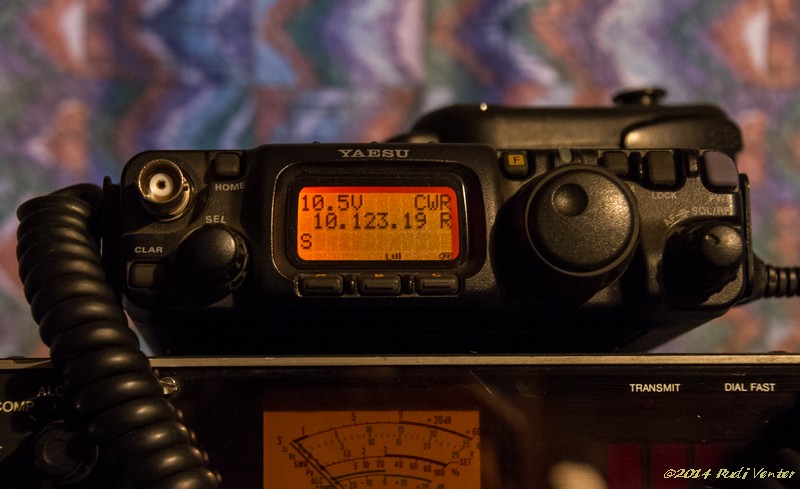
Yaesu
FT-817
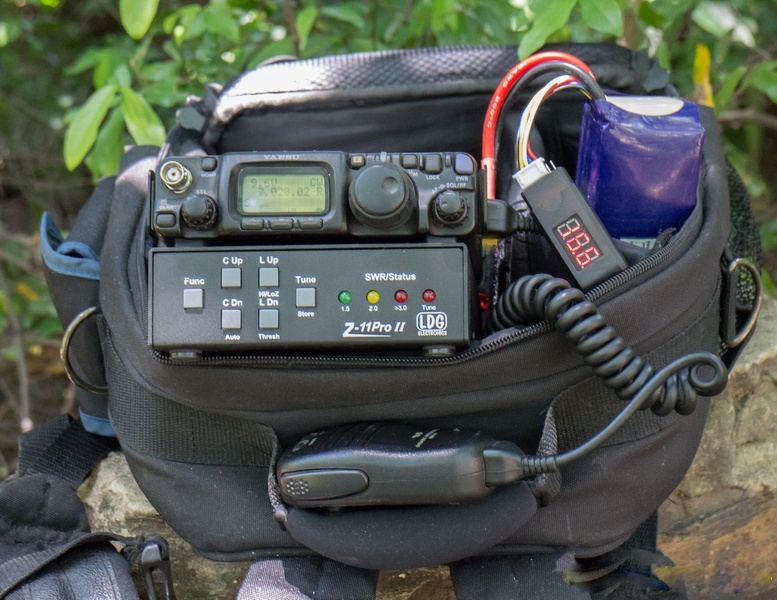
FT-817 with LDG tuner and LiPo battery, QRP contest portable station.
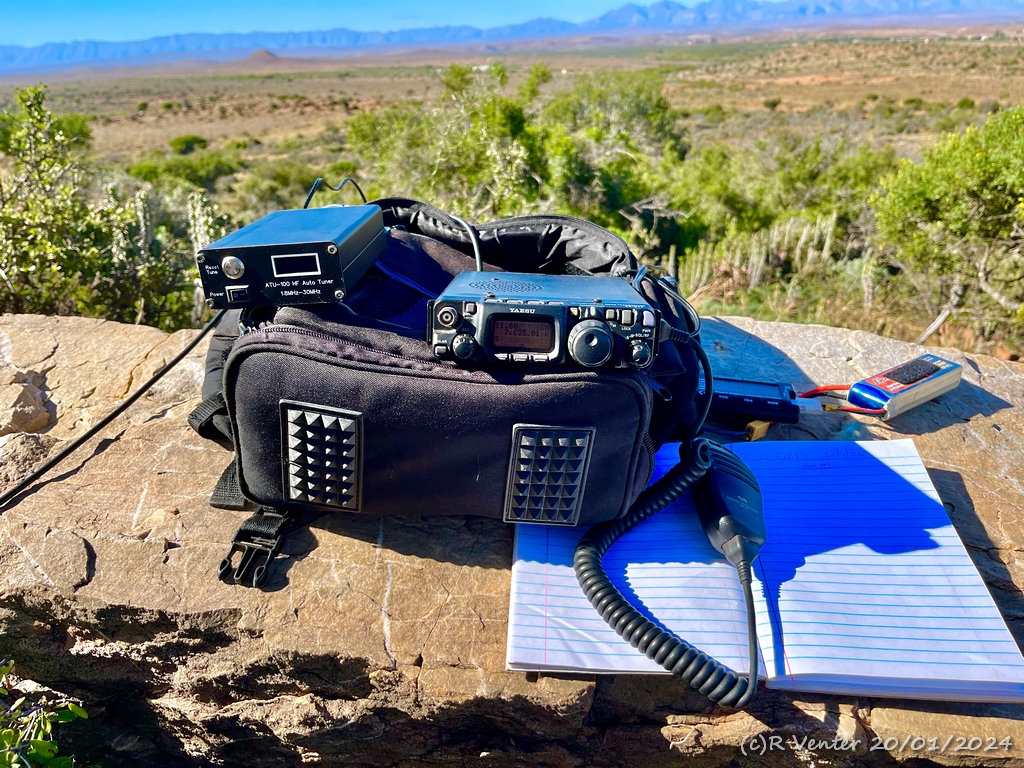
Having fun with the FT-817 during a QRP contest. 2024
The FT-817 was also used from the shack for many CQWW and ARRL contests
running in the QRP class. It always performed well, my only wish was that it
had better noise canceling abilities and a narrow CW filter.
You can
install a narrow CW filter and I did look for one but could not find one for a
decent price. This was the main reason I started looking for a replacement
around 2021. The initial radio I replaced the FT-817 with was the little R928+
SDR radio. In many was it was an improvement but I initially had some
reliability issues with it so the FT-817 remained in service for a while along
with "replacements".
(c)R Venter 1996-2024
Home